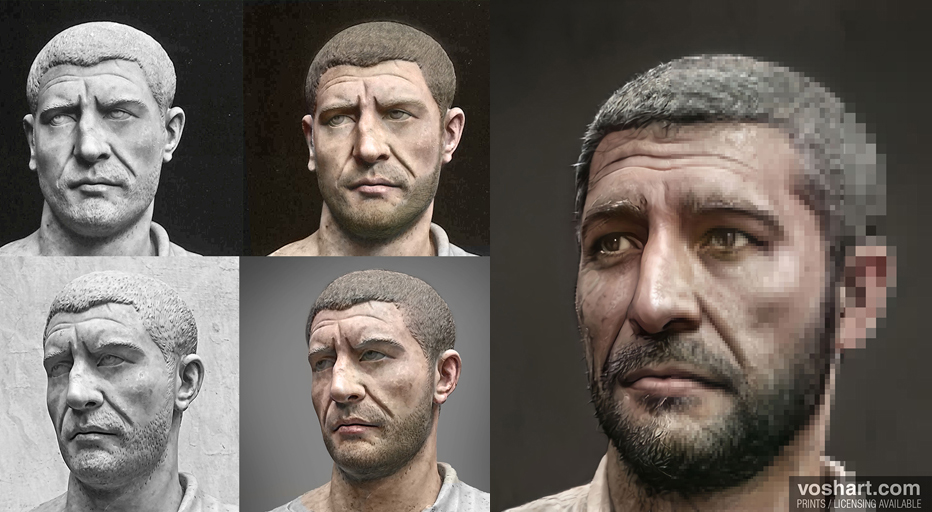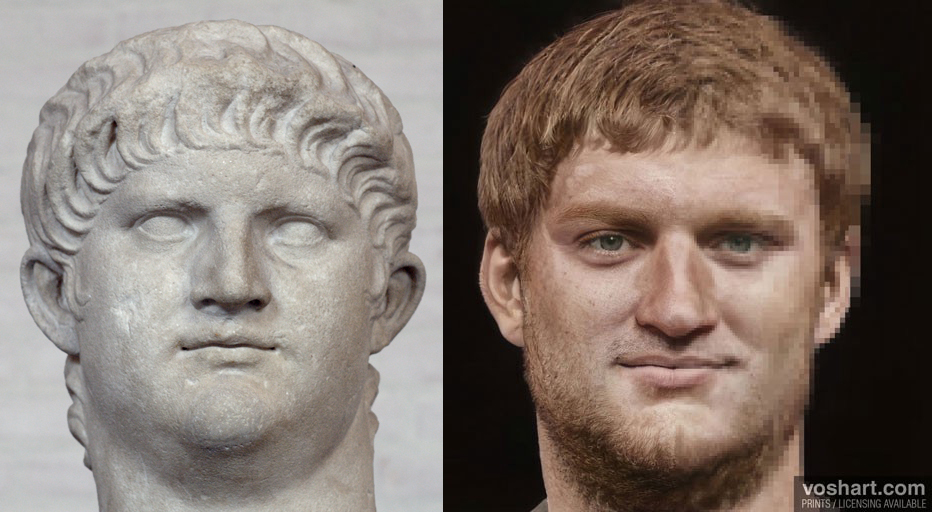AI 'resurrects' 54 Roman emperors, in stunningly lifelike images
An artist used machine learning to create the photorealistic portraits.

Ancient Roman emperors' faces have been brought to life in digital reconstructions; the unnervingly realistic image project includes the Emperors Caligula, Nero and Hadrian, among others.
The features of these long-dead rulers have been preserved in hundreds of sculptures, but even the most detailed carvings can't convey what these men truly looked like when they were alive. To explore that, Canadian cinematographer and virtual reality designer Daniel Voshart used machine learning — computer algorithms that learn through experience — in a neural network, a computing system processes information through hierarchies of nodes that communicate in a manner similar to neurons in a brain.
In the neural net, called Artbreeder, algorithms analyzed about 800 busts to model more realistic facial shapes, features, hair and skin, and to add vivid color. Voshart then fine-tuned Artbreeder's models using Photoshop, adding details gleaned from coins, artworks and written descriptions of the emperors from historical texts, to make the portraits really come to life.
Related: Photos: The reconstruction of a teen who lived 9,000 years ago
"There is a rule of thumb in computer programming called 'garbage in garbage out,' and it applies to Artbreeder," Voshart told Live Science in an email. "A well-lit, well-sculpted bust with little damage and standard face features is going to be quite easy to get a result." In contrast, a dataset including damaged sculptures or ones photographed under poor lighting can produce proverbial "garbage" images that aren't very realistic.
The busts that Voshart preferred to use as the primary sources were carved when their emperor subject was still alive, or were the most skillfully made, he said in a blog post.
For skin color, Voshart would either provide Artbreeder with a colorized reference image, or let it "guess" how to distribute hues so that the surface of the model resembled realistic human skin.
Get the world’s most fascinating discoveries delivered straight to your inbox.
"I can change skin tone and change ethnicity somewhat with manual controls," he said.
Tracking down all the art and reference text for the emperors took approximately two months, and assembling each portrait required about 15 to 16 hours on average, Voshart told Live Science.
For the emperor Caligula, who ruled from A.D. 37 to 41, Voshart adjusted the Artbreeder model using descriptions that included "head misshapen, eyes and temples sunken," and "eyes staring and with a glare savage enough to torture," from a paper titled "Personal Appearance in the Biography of the Roman Emperors," published in 1928 in the journal Studies in Philology.
Nero, emperor from A.D. 54 to 68, had a more rounded jaw, skin that was "freckled and repulsive," and a face that was "agreeable rather than attractive," according to the 1928 paper.
Related: The weird reason so many Roman emperors were assassinated
When Voshart began the Roman Emperor Project as a distraction during the COVID-19 quarantine, his knowledge of the ancient emperors was "close to zero," he said. Nevertheless, what started as a diverting art experiment intrigued Voshart enough to eventually include 54 emperors, spanning a period in the Roman Empire that is sometimes called the Principate, from 27 B.C. to A.D. 285, he wrote on his website.
Knowing little about his subjects was actually a plus, allowing him to shape their faces without preconceptions or bias, Voshart said.
"In a forensic reconstruction, for example, you only want relevant information about hair, skin, known scars," and other physical features, Voshart explained. "Knowing aspects of personality can unduly influence an artist," leading them to craft a portrait that reflects a skewed perception of the subject, he said.
You can see more of Voshart's reconstructions on his website, and a poster of the 54 faces in the Roman Emperor Project is available at his Etsy store.
Originally published on Live Science.

Mindy Weisberger is a science journalist and author of "Rise of the Zombie Bugs: The Surprising Science of Parasitic Mind-Control" (Hopkins Press). She formerly edited for Scholastic and was a channel editor and senior writer for Live Science. She has reported on general science, covering climate change, paleontology, biology and space. Mindy studied film at Columbia University; prior to LS, she produced, wrote and directed media for the American Museum of Natural History in NYC. Her videos about dinosaurs, astrophysics, biodiversity and evolution appear in museums and science centers worldwide, earning awards such as the CINE Golden Eagle and the Communicator Award of Excellence. Her writing has also appeared in Scientific American, The Washington Post, How It Works Magazine and CNN.




